Developing Patterns and Algebra Skills: A Year 5/6 Math Lesson Plan
VerifiedAdded on 2019/11/26
|10
|2271
|285
Homework Assignment
AI Summary
This assignment presents a detailed lesson plan designed for a Year 5 or 6 classroom, focusing on the mathematical concepts of patterns and algebra. The plan, targeting a class of 20 students with one student having hearing difficulties, emphasizes a student-centered approach, valuing questions and diverse learning models. The lesson is divided into three sessions, each approximately 60 minutes long, covering topics from introducing patterns and algebra using interactive videos and group activities, to exploring patterns with fractions, decimals, and whole numbers, and finally, delving into number sentences involving multiplication and division. The plan incorporates various assessment methods, including group participation, quizzes, and journal reviews, and emphasizes differentiation strategies to cater to students with special needs. The plan also addresses common misconceptions about algebra, promoting real-world connections and cross-curriculum priorities such as Asia and Australia engagement and sustainability, fostering social inclusion and critical thinking skills. The lesson plan utilizes resources like interactive whiteboards, Mathletic’s teacher login, computers, math journals, and handouts, with the overall goal of making patterns and algebra accessible and engaging for all students.

Title
Name
Instructor’s name
Date
Name
Instructor’s name
Date
Paraphrase This Document
Need a fresh take? Get an instant paraphrase of this document with our AI Paraphraser
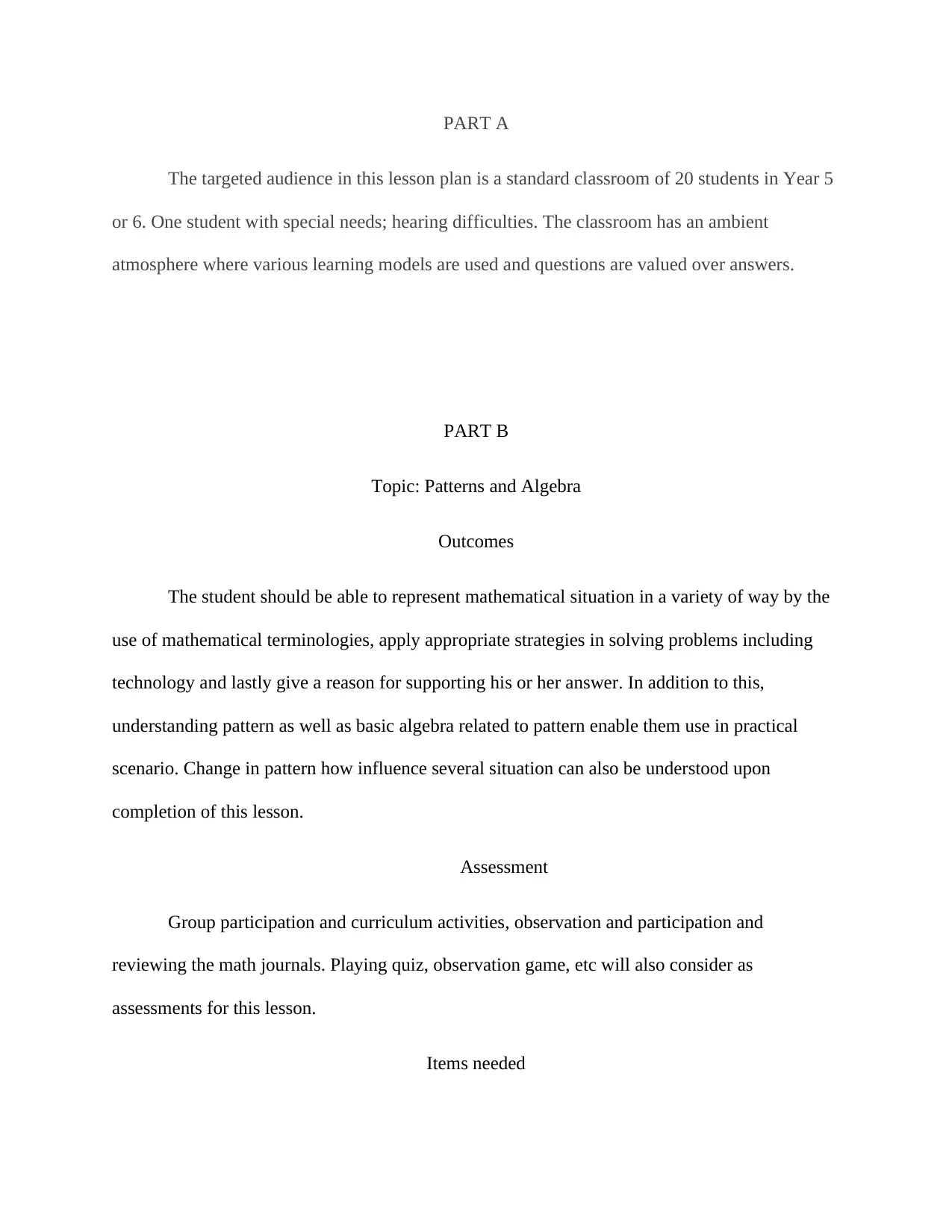
PART A
The targeted audience in this lesson plan is a standard classroom of 20 students in Year 5
or 6. One student with special needs; hearing difficulties. The classroom has an ambient
atmosphere where various learning models are used and questions are valued over answers.
PART B
Topic: Patterns and Algebra
Outcomes
The student should be able to represent mathematical situation in a variety of way by the
use of mathematical terminologies, apply appropriate strategies in solving problems including
technology and lastly give a reason for supporting his or her answer. In addition to this,
understanding pattern as well as basic algebra related to pattern enable them use in practical
scenario. Change in pattern how influence several situation can also be understood upon
completion of this lesson.
Assessment
Group participation and curriculum activities, observation and participation and
reviewing the math journals. Playing quiz, observation game, etc will also consider as
assessments for this lesson.
Items needed
The targeted audience in this lesson plan is a standard classroom of 20 students in Year 5
or 6. One student with special needs; hearing difficulties. The classroom has an ambient
atmosphere where various learning models are used and questions are valued over answers.
PART B
Topic: Patterns and Algebra
Outcomes
The student should be able to represent mathematical situation in a variety of way by the
use of mathematical terminologies, apply appropriate strategies in solving problems including
technology and lastly give a reason for supporting his or her answer. In addition to this,
understanding pattern as well as basic algebra related to pattern enable them use in practical
scenario. Change in pattern how influence several situation can also be understood upon
completion of this lesson.
Assessment
Group participation and curriculum activities, observation and participation and
reviewing the math journals. Playing quiz, observation game, etc will also consider as
assessments for this lesson.
Items needed
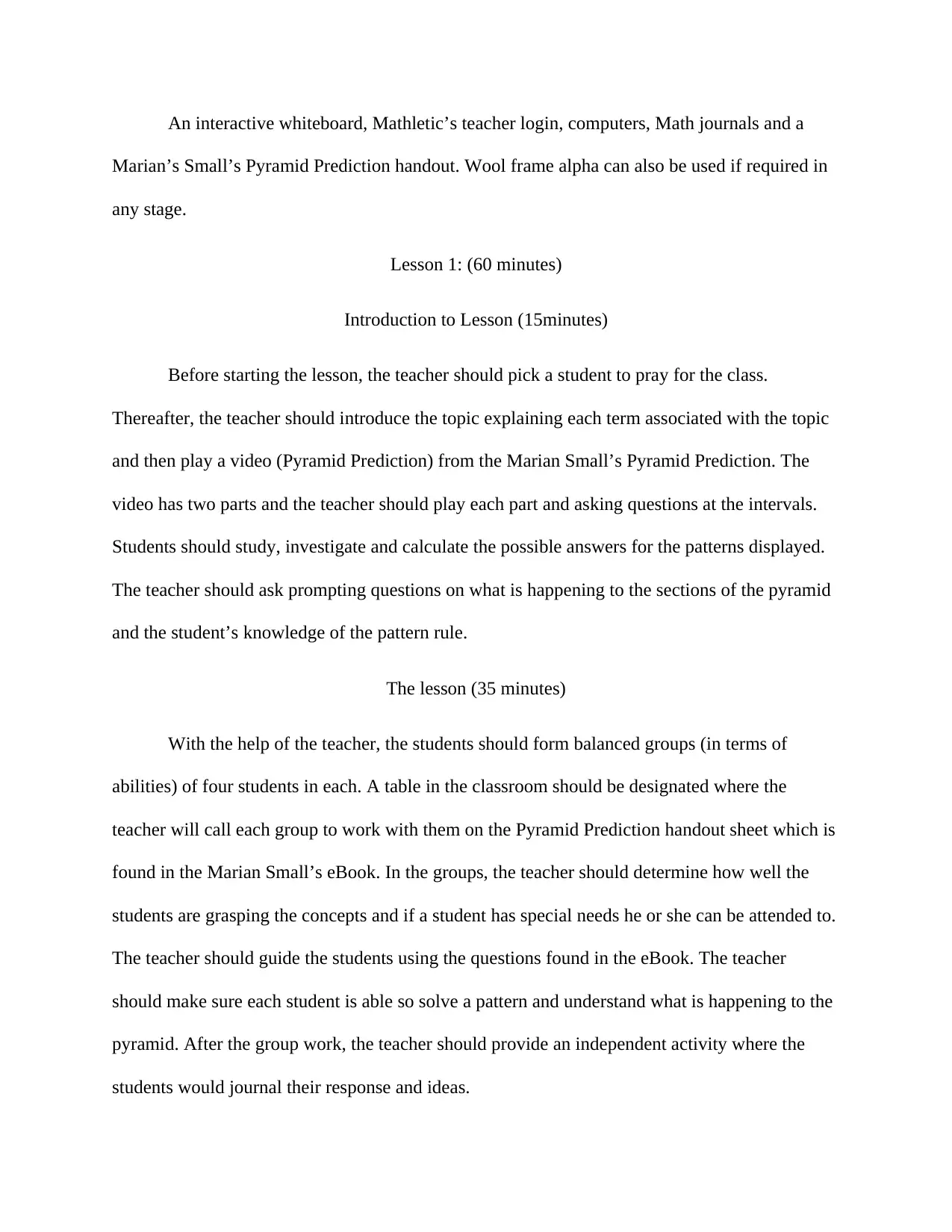
An interactive whiteboard, Mathletic’s teacher login, computers, Math journals and a
Marian’s Small’s Pyramid Prediction handout. Wool frame alpha can also be used if required in
any stage.
Lesson 1: (60 minutes)
Introduction to Lesson (15minutes)
Before starting the lesson, the teacher should pick a student to pray for the class.
Thereafter, the teacher should introduce the topic explaining each term associated with the topic
and then play a video (Pyramid Prediction) from the Marian Small’s Pyramid Prediction. The
video has two parts and the teacher should play each part and asking questions at the intervals.
Students should study, investigate and calculate the possible answers for the patterns displayed.
The teacher should ask prompting questions on what is happening to the sections of the pyramid
and the student’s knowledge of the pattern rule.
The lesson (35 minutes)
With the help of the teacher, the students should form balanced groups (in terms of
abilities) of four students in each. A table in the classroom should be designated where the
teacher will call each group to work with them on the Pyramid Prediction handout sheet which is
found in the Marian Small’s eBook. In the groups, the teacher should determine how well the
students are grasping the concepts and if a student has special needs he or she can be attended to.
The teacher should guide the students using the questions found in the eBook. The teacher
should make sure each student is able so solve a pattern and understand what is happening to the
pyramid. After the group work, the teacher should provide an independent activity where the
students would journal their response and ideas.
Marian’s Small’s Pyramid Prediction handout. Wool frame alpha can also be used if required in
any stage.
Lesson 1: (60 minutes)
Introduction to Lesson (15minutes)
Before starting the lesson, the teacher should pick a student to pray for the class.
Thereafter, the teacher should introduce the topic explaining each term associated with the topic
and then play a video (Pyramid Prediction) from the Marian Small’s Pyramid Prediction. The
video has two parts and the teacher should play each part and asking questions at the intervals.
Students should study, investigate and calculate the possible answers for the patterns displayed.
The teacher should ask prompting questions on what is happening to the sections of the pyramid
and the student’s knowledge of the pattern rule.
The lesson (35 minutes)
With the help of the teacher, the students should form balanced groups (in terms of
abilities) of four students in each. A table in the classroom should be designated where the
teacher will call each group to work with them on the Pyramid Prediction handout sheet which is
found in the Marian Small’s eBook. In the groups, the teacher should determine how well the
students are grasping the concepts and if a student has special needs he or she can be attended to.
The teacher should guide the students using the questions found in the eBook. The teacher
should make sure each student is able so solve a pattern and understand what is happening to the
pyramid. After the group work, the teacher should provide an independent activity where the
students would journal their response and ideas.
⊘ This is a preview!⊘
Do you want full access?
Subscribe today to unlock all pages.

Trusted by 1+ million students worldwide
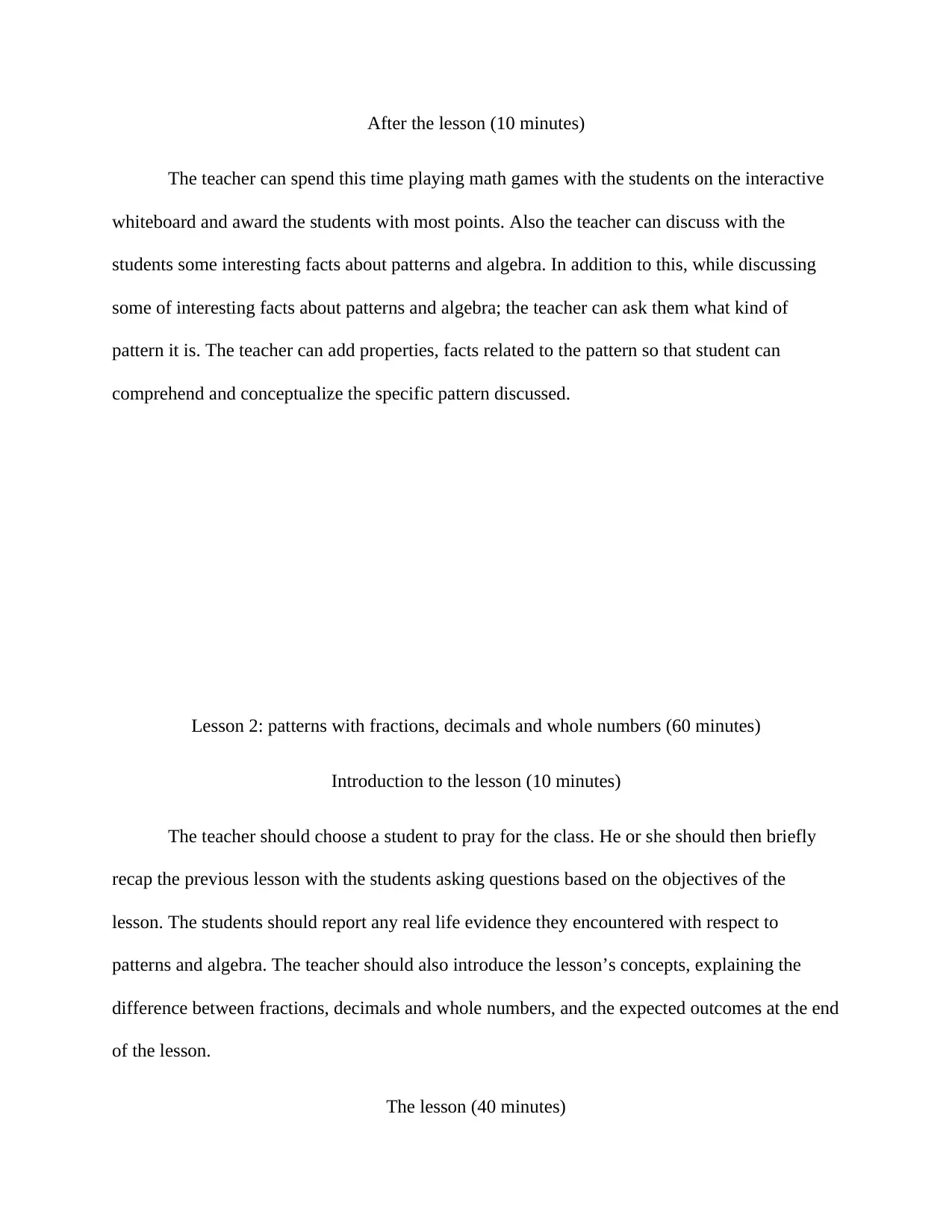
After the lesson (10 minutes)
The teacher can spend this time playing math games with the students on the interactive
whiteboard and award the students with most points. Also the teacher can discuss with the
students some interesting facts about patterns and algebra. In addition to this, while discussing
some of interesting facts about patterns and algebra; the teacher can ask them what kind of
pattern it is. The teacher can add properties, facts related to the pattern so that student can
comprehend and conceptualize the specific pattern discussed.
Lesson 2: patterns with fractions, decimals and whole numbers (60 minutes)
Introduction to the lesson (10 minutes)
The teacher should choose a student to pray for the class. He or she should then briefly
recap the previous lesson with the students asking questions based on the objectives of the
lesson. The students should report any real life evidence they encountered with respect to
patterns and algebra. The teacher should also introduce the lesson’s concepts, explaining the
difference between fractions, decimals and whole numbers, and the expected outcomes at the end
of the lesson.
The lesson (40 minutes)
The teacher can spend this time playing math games with the students on the interactive
whiteboard and award the students with most points. Also the teacher can discuss with the
students some interesting facts about patterns and algebra. In addition to this, while discussing
some of interesting facts about patterns and algebra; the teacher can ask them what kind of
pattern it is. The teacher can add properties, facts related to the pattern so that student can
comprehend and conceptualize the specific pattern discussed.
Lesson 2: patterns with fractions, decimals and whole numbers (60 minutes)
Introduction to the lesson (10 minutes)
The teacher should choose a student to pray for the class. He or she should then briefly
recap the previous lesson with the students asking questions based on the objectives of the
lesson. The students should report any real life evidence they encountered with respect to
patterns and algebra. The teacher should also introduce the lesson’s concepts, explaining the
difference between fractions, decimals and whole numbers, and the expected outcomes at the end
of the lesson.
The lesson (40 minutes)
Paraphrase This Document
Need a fresh take? Get an instant paraphrase of this document with our AI Paraphraser
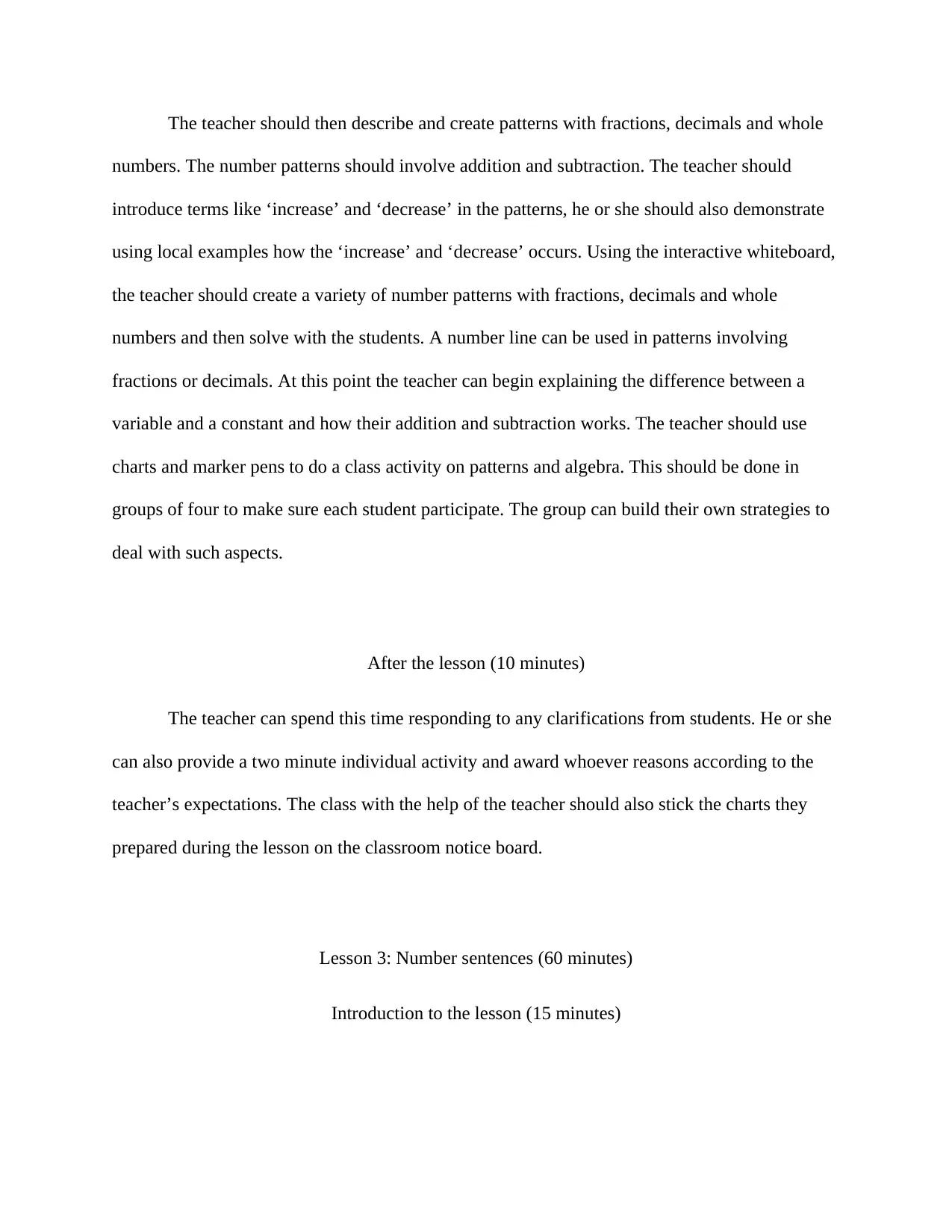
The teacher should then describe and create patterns with fractions, decimals and whole
numbers. The number patterns should involve addition and subtraction. The teacher should
introduce terms like ‘increase’ and ‘decrease’ in the patterns, he or she should also demonstrate
using local examples how the ‘increase’ and ‘decrease’ occurs. Using the interactive whiteboard,
the teacher should create a variety of number patterns with fractions, decimals and whole
numbers and then solve with the students. A number line can be used in patterns involving
fractions or decimals. At this point the teacher can begin explaining the difference between a
variable and a constant and how their addition and subtraction works. The teacher should use
charts and marker pens to do a class activity on patterns and algebra. This should be done in
groups of four to make sure each student participate. The group can build their own strategies to
deal with such aspects.
After the lesson (10 minutes)
The teacher can spend this time responding to any clarifications from students. He or she
can also provide a two minute individual activity and award whoever reasons according to the
teacher’s expectations. The class with the help of the teacher should also stick the charts they
prepared during the lesson on the classroom notice board.
Lesson 3: Number sentences (60 minutes)
Introduction to the lesson (15 minutes)
numbers. The number patterns should involve addition and subtraction. The teacher should
introduce terms like ‘increase’ and ‘decrease’ in the patterns, he or she should also demonstrate
using local examples how the ‘increase’ and ‘decrease’ occurs. Using the interactive whiteboard,
the teacher should create a variety of number patterns with fractions, decimals and whole
numbers and then solve with the students. A number line can be used in patterns involving
fractions or decimals. At this point the teacher can begin explaining the difference between a
variable and a constant and how their addition and subtraction works. The teacher should use
charts and marker pens to do a class activity on patterns and algebra. This should be done in
groups of four to make sure each student participate. The group can build their own strategies to
deal with such aspects.
After the lesson (10 minutes)
The teacher can spend this time responding to any clarifications from students. He or she
can also provide a two minute individual activity and award whoever reasons according to the
teacher’s expectations. The class with the help of the teacher should also stick the charts they
prepared during the lesson on the classroom notice board.
Lesson 3: Number sentences (60 minutes)
Introduction to the lesson (15 minutes)
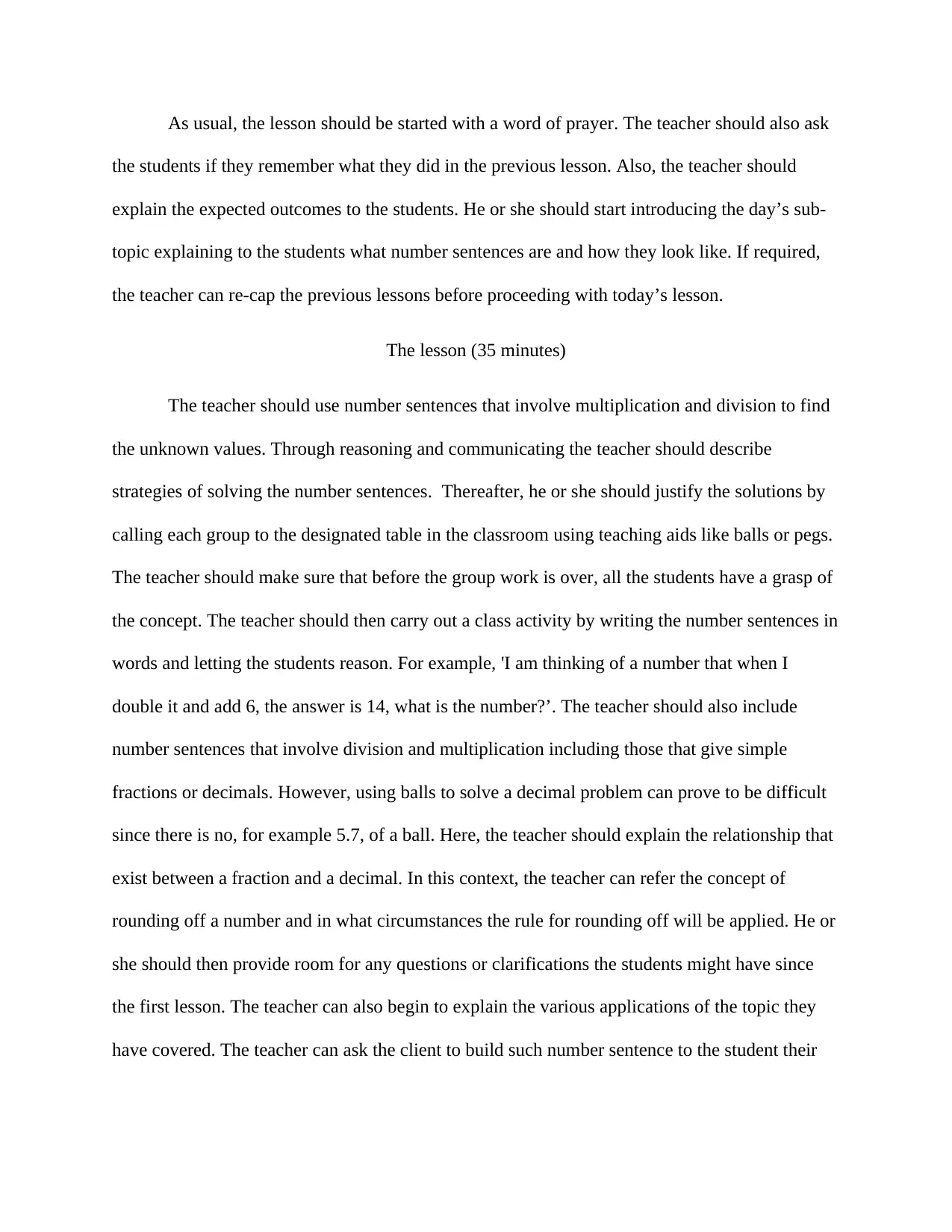
As usual, the lesson should be started with a word of prayer. The teacher should also ask
the students if they remember what they did in the previous lesson. Also, the teacher should
explain the expected outcomes to the students. He or she should start introducing the day’s sub-
topic explaining to the students what number sentences are and how they look like. If required,
the teacher can re-cap the previous lessons before proceeding with today’s lesson.
The lesson (35 minutes)
The teacher should use number sentences that involve multiplication and division to find
the unknown values. Through reasoning and communicating the teacher should describe
strategies of solving the number sentences. Thereafter, he or she should justify the solutions by
calling each group to the designated table in the classroom using teaching aids like balls or pegs.
The teacher should make sure that before the group work is over, all the students have a grasp of
the concept. The teacher should then carry out a class activity by writing the number sentences in
words and letting the students reason. For example, 'I am thinking of a number that when I
double it and add 6, the answer is 14, what is the number?’. The teacher should also include
number sentences that involve division and multiplication including those that give simple
fractions or decimals. However, using balls to solve a decimal problem can prove to be difficult
since there is no, for example 5.7, of a ball. Here, the teacher should explain the relationship that
exist between a fraction and a decimal. In this context, the teacher can refer the concept of
rounding off a number and in what circumstances the rule for rounding off will be applied. He or
she should then provide room for any questions or clarifications the students might have since
the first lesson. The teacher can also begin to explain the various applications of the topic they
have covered. The teacher can ask the client to build such number sentence to the student their
the students if they remember what they did in the previous lesson. Also, the teacher should
explain the expected outcomes to the students. He or she should start introducing the day’s sub-
topic explaining to the students what number sentences are and how they look like. If required,
the teacher can re-cap the previous lessons before proceeding with today’s lesson.
The lesson (35 minutes)
The teacher should use number sentences that involve multiplication and division to find
the unknown values. Through reasoning and communicating the teacher should describe
strategies of solving the number sentences. Thereafter, he or she should justify the solutions by
calling each group to the designated table in the classroom using teaching aids like balls or pegs.
The teacher should make sure that before the group work is over, all the students have a grasp of
the concept. The teacher should then carry out a class activity by writing the number sentences in
words and letting the students reason. For example, 'I am thinking of a number that when I
double it and add 6, the answer is 14, what is the number?’. The teacher should also include
number sentences that involve division and multiplication including those that give simple
fractions or decimals. However, using balls to solve a decimal problem can prove to be difficult
since there is no, for example 5.7, of a ball. Here, the teacher should explain the relationship that
exist between a fraction and a decimal. In this context, the teacher can refer the concept of
rounding off a number and in what circumstances the rule for rounding off will be applied. He or
she should then provide room for any questions or clarifications the students might have since
the first lesson. The teacher can also begin to explain the various applications of the topic they
have covered. The teacher can ask the client to build such number sentence to the student their
⊘ This is a preview!⊘
Do you want full access?
Subscribe today to unlock all pages.

Trusted by 1+ million students worldwide
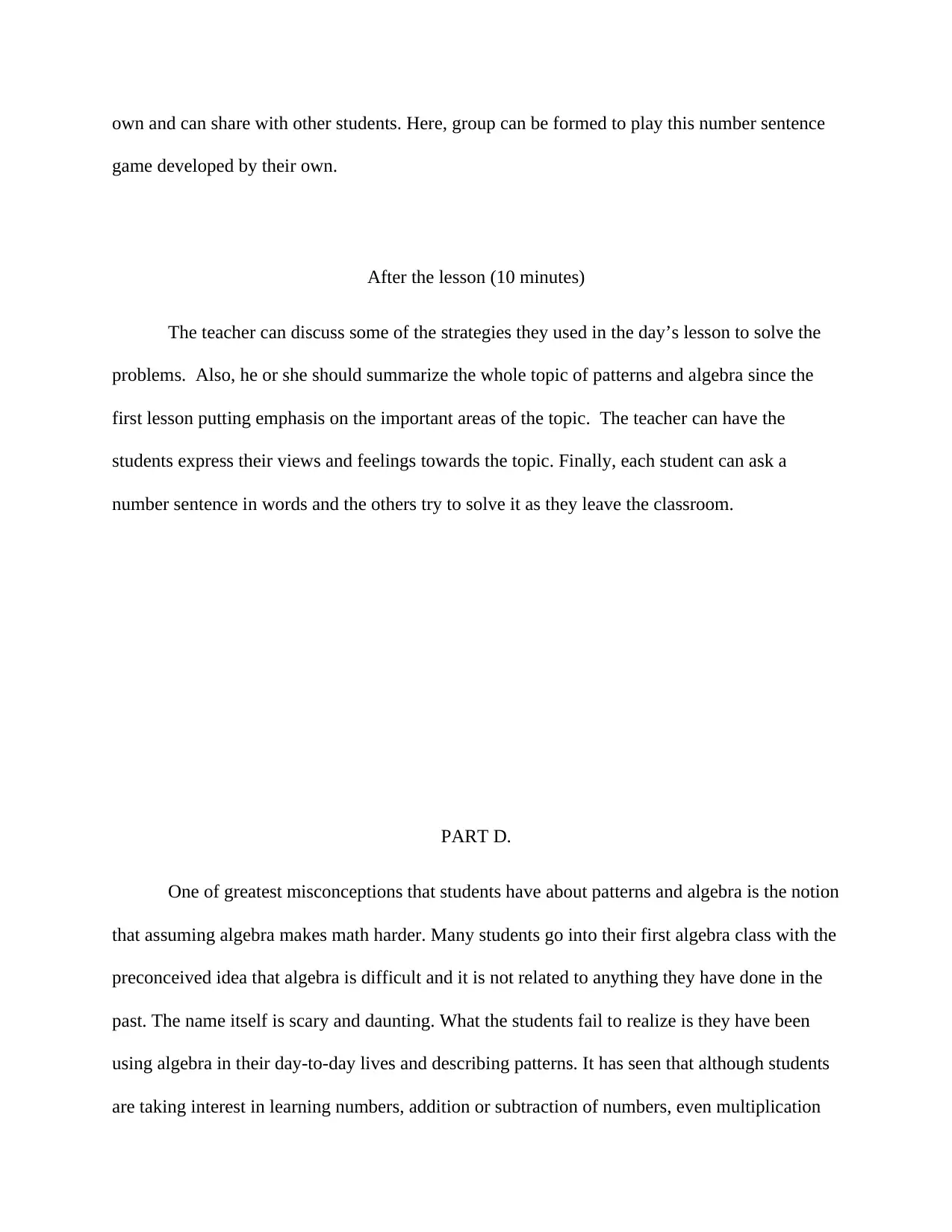
own and can share with other students. Here, group can be formed to play this number sentence
game developed by their own.
After the lesson (10 minutes)
The teacher can discuss some of the strategies they used in the day’s lesson to solve the
problems. Also, he or she should summarize the whole topic of patterns and algebra since the
first lesson putting emphasis on the important areas of the topic. The teacher can have the
students express their views and feelings towards the topic. Finally, each student can ask a
number sentence in words and the others try to solve it as they leave the classroom.
PART D.
One of greatest misconceptions that students have about patterns and algebra is the notion
that assuming algebra makes math harder. Many students go into their first algebra class with the
preconceived idea that algebra is difficult and it is not related to anything they have done in the
past. The name itself is scary and daunting. What the students fail to realize is they have been
using algebra in their day-to-day lives and describing patterns. It has seen that although students
are taking interest in learning numbers, addition or subtraction of numbers, even multiplication
game developed by their own.
After the lesson (10 minutes)
The teacher can discuss some of the strategies they used in the day’s lesson to solve the
problems. Also, he or she should summarize the whole topic of patterns and algebra since the
first lesson putting emphasis on the important areas of the topic. The teacher can have the
students express their views and feelings towards the topic. Finally, each student can ask a
number sentence in words and the others try to solve it as they leave the classroom.
PART D.
One of greatest misconceptions that students have about patterns and algebra is the notion
that assuming algebra makes math harder. Many students go into their first algebra class with the
preconceived idea that algebra is difficult and it is not related to anything they have done in the
past. The name itself is scary and daunting. What the students fail to realize is they have been
using algebra in their day-to-day lives and describing patterns. It has seen that although students
are taking interest in learning numbers, addition or subtraction of numbers, even multiplication
Paraphrase This Document
Need a fresh take? Get an instant paraphrase of this document with our AI Paraphraser
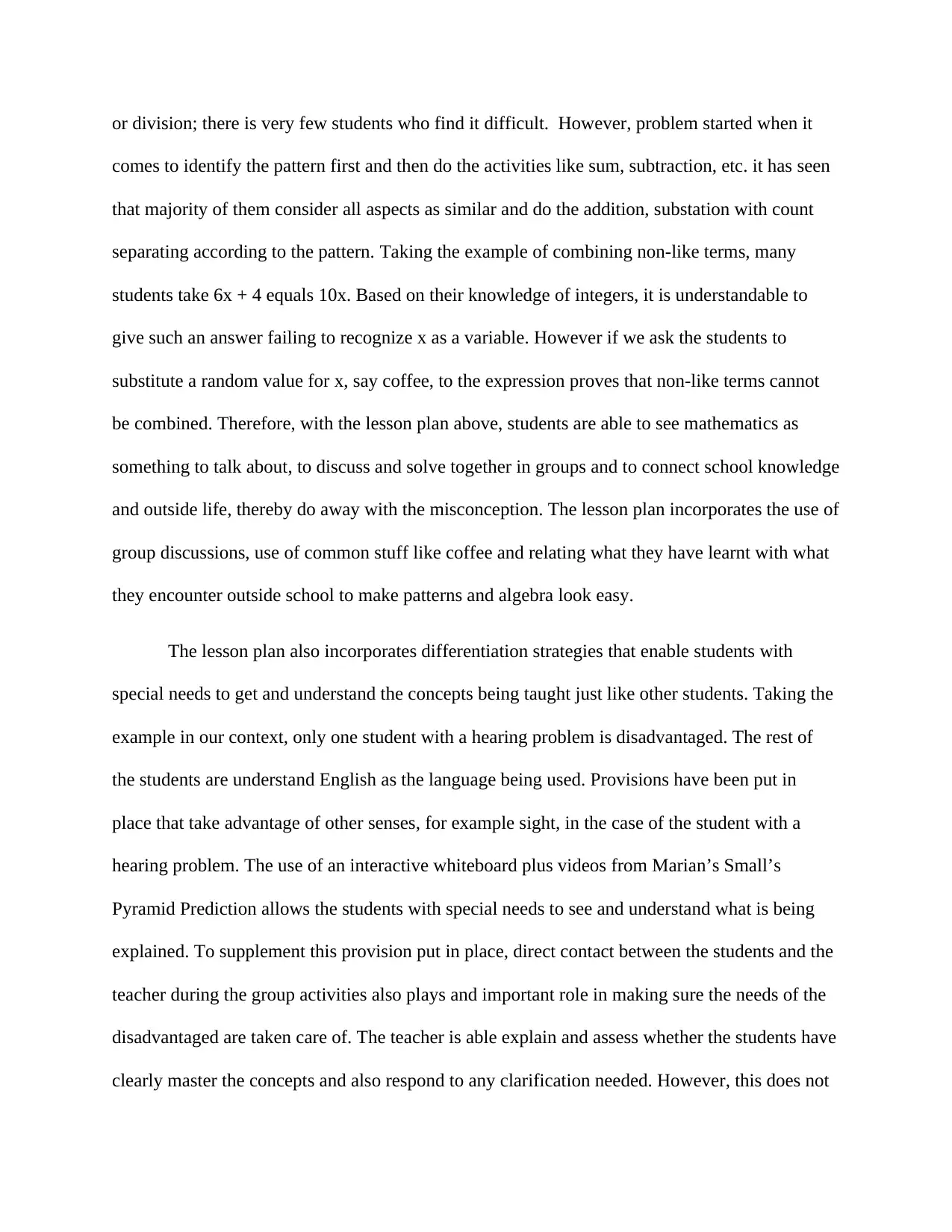
or division; there is very few students who find it difficult. However, problem started when it
comes to identify the pattern first and then do the activities like sum, subtraction, etc. it has seen
that majority of them consider all aspects as similar and do the addition, substation with count
separating according to the pattern. Taking the example of combining non-like terms, many
students take 6x + 4 equals 10x. Based on their knowledge of integers, it is understandable to
give such an answer failing to recognize x as a variable. However if we ask the students to
substitute a random value for x, say coffee, to the expression proves that non-like terms cannot
be combined. Therefore, with the lesson plan above, students are able to see mathematics as
something to talk about, to discuss and solve together in groups and to connect school knowledge
and outside life, thereby do away with the misconception. The lesson plan incorporates the use of
group discussions, use of common stuff like coffee and relating what they have learnt with what
they encounter outside school to make patterns and algebra look easy.
The lesson plan also incorporates differentiation strategies that enable students with
special needs to get and understand the concepts being taught just like other students. Taking the
example in our context, only one student with a hearing problem is disadvantaged. The rest of
the students are understand English as the language being used. Provisions have been put in
place that take advantage of other senses, for example sight, in the case of the student with a
hearing problem. The use of an interactive whiteboard plus videos from Marian’s Small’s
Pyramid Prediction allows the students with special needs to see and understand what is being
explained. To supplement this provision put in place, direct contact between the students and the
teacher during the group activities also plays and important role in making sure the needs of the
disadvantaged are taken care of. The teacher is able explain and assess whether the students have
clearly master the concepts and also respond to any clarification needed. However, this does not
comes to identify the pattern first and then do the activities like sum, subtraction, etc. it has seen
that majority of them consider all aspects as similar and do the addition, substation with count
separating according to the pattern. Taking the example of combining non-like terms, many
students take 6x + 4 equals 10x. Based on their knowledge of integers, it is understandable to
give such an answer failing to recognize x as a variable. However if we ask the students to
substitute a random value for x, say coffee, to the expression proves that non-like terms cannot
be combined. Therefore, with the lesson plan above, students are able to see mathematics as
something to talk about, to discuss and solve together in groups and to connect school knowledge
and outside life, thereby do away with the misconception. The lesson plan incorporates the use of
group discussions, use of common stuff like coffee and relating what they have learnt with what
they encounter outside school to make patterns and algebra look easy.
The lesson plan also incorporates differentiation strategies that enable students with
special needs to get and understand the concepts being taught just like other students. Taking the
example in our context, only one student with a hearing problem is disadvantaged. The rest of
the students are understand English as the language being used. Provisions have been put in
place that take advantage of other senses, for example sight, in the case of the student with a
hearing problem. The use of an interactive whiteboard plus videos from Marian’s Small’s
Pyramid Prediction allows the students with special needs to see and understand what is being
explained. To supplement this provision put in place, direct contact between the students and the
teacher during the group activities also plays and important role in making sure the needs of the
disadvantaged are taken care of. The teacher is able explain and assess whether the students have
clearly master the concepts and also respond to any clarification needed. However, this does not
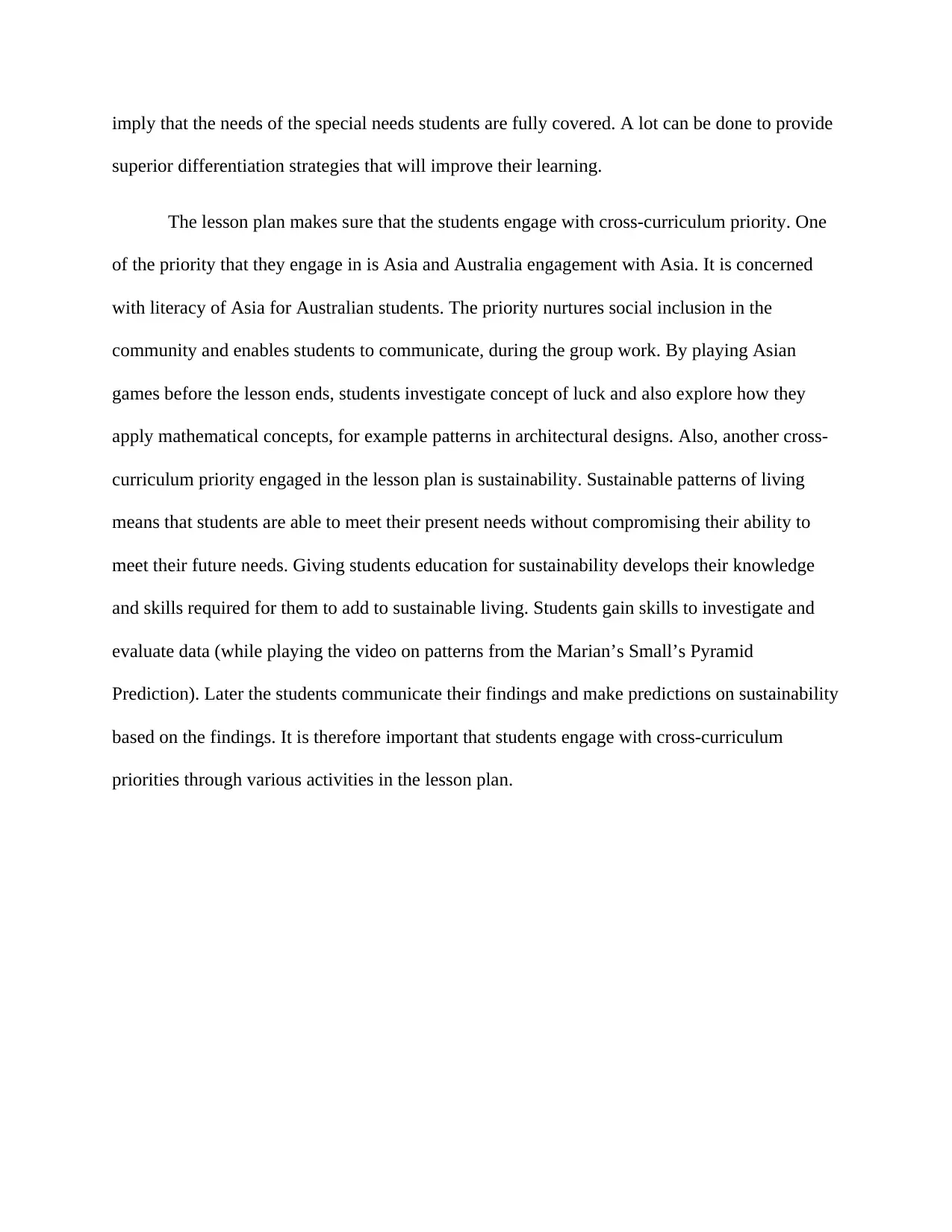
imply that the needs of the special needs students are fully covered. A lot can be done to provide
superior differentiation strategies that will improve their learning.
The lesson plan makes sure that the students engage with cross-curriculum priority. One
of the priority that they engage in is Asia and Australia engagement with Asia. It is concerned
with literacy of Asia for Australian students. The priority nurtures social inclusion in the
community and enables students to communicate, during the group work. By playing Asian
games before the lesson ends, students investigate concept of luck and also explore how they
apply mathematical concepts, for example patterns in architectural designs. Also, another cross-
curriculum priority engaged in the lesson plan is sustainability. Sustainable patterns of living
means that students are able to meet their present needs without compromising their ability to
meet their future needs. Giving students education for sustainability develops their knowledge
and skills required for them to add to sustainable living. Students gain skills to investigate and
evaluate data (while playing the video on patterns from the Marian’s Small’s Pyramid
Prediction). Later the students communicate their findings and make predictions on sustainability
based on the findings. It is therefore important that students engage with cross-curriculum
priorities through various activities in the lesson plan.
superior differentiation strategies that will improve their learning.
The lesson plan makes sure that the students engage with cross-curriculum priority. One
of the priority that they engage in is Asia and Australia engagement with Asia. It is concerned
with literacy of Asia for Australian students. The priority nurtures social inclusion in the
community and enables students to communicate, during the group work. By playing Asian
games before the lesson ends, students investigate concept of luck and also explore how they
apply mathematical concepts, for example patterns in architectural designs. Also, another cross-
curriculum priority engaged in the lesson plan is sustainability. Sustainable patterns of living
means that students are able to meet their present needs without compromising their ability to
meet their future needs. Giving students education for sustainability develops their knowledge
and skills required for them to add to sustainable living. Students gain skills to investigate and
evaluate data (while playing the video on patterns from the Marian’s Small’s Pyramid
Prediction). Later the students communicate their findings and make predictions on sustainability
based on the findings. It is therefore important that students engage with cross-curriculum
priorities through various activities in the lesson plan.
⊘ This is a preview!⊘
Do you want full access?
Subscribe today to unlock all pages.

Trusted by 1+ million students worldwide
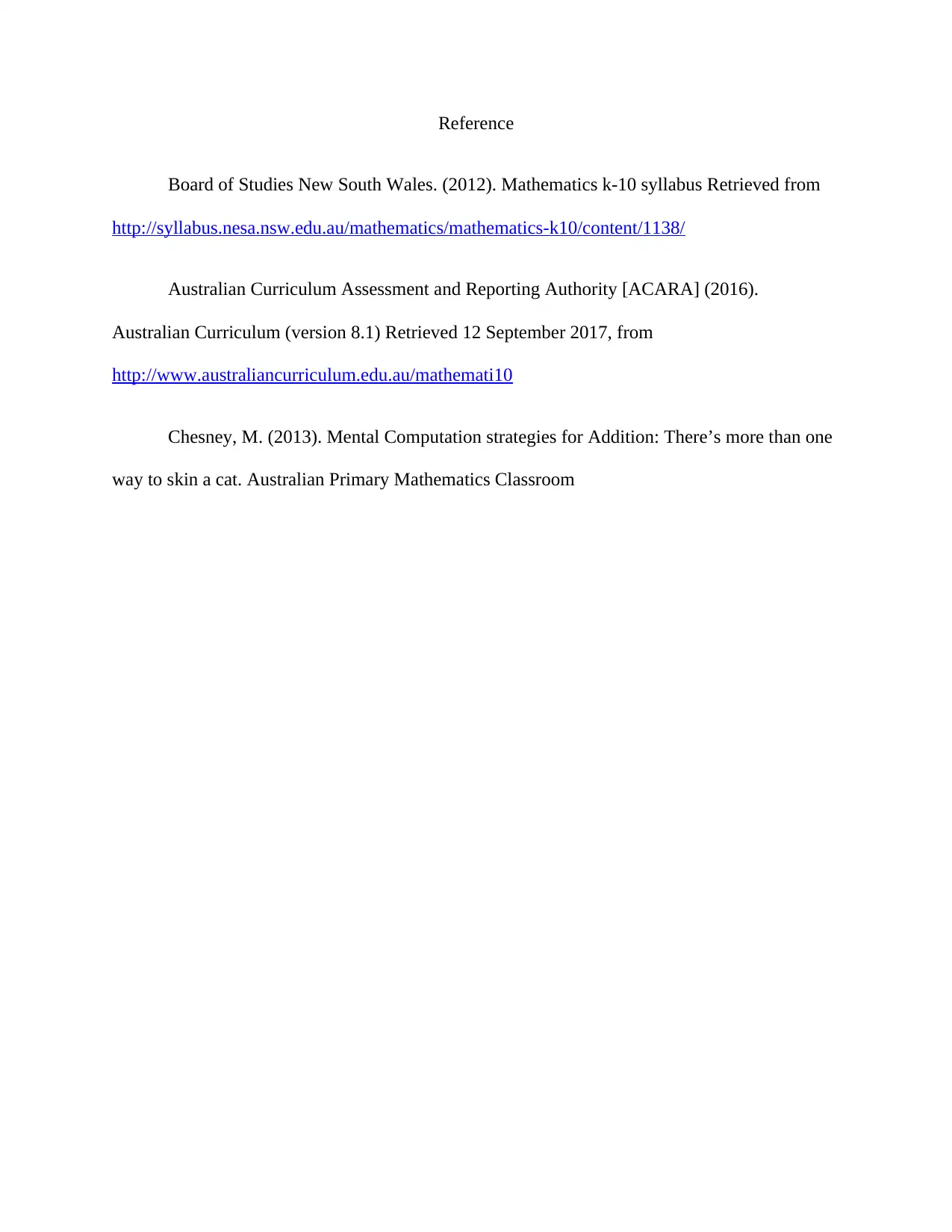
Reference
Board of Studies New South Wales. (2012). Mathematics k-10 syllabus Retrieved from
http://syllabus.nesa.nsw.edu.au/mathematics/mathematics-k10/content/1138/
Australian Curriculum Assessment and Reporting Authority [ACARA] (2016).
Australian Curriculum (version 8.1) Retrieved 12 September 2017, from
http://www.australiancurriculum.edu.au/mathemati10
Chesney, M. (2013). Mental Computation strategies for Addition: There’s more than one
way to skin a cat. Australian Primary Mathematics Classroom
Board of Studies New South Wales. (2012). Mathematics k-10 syllabus Retrieved from
http://syllabus.nesa.nsw.edu.au/mathematics/mathematics-k10/content/1138/
Australian Curriculum Assessment and Reporting Authority [ACARA] (2016).
Australian Curriculum (version 8.1) Retrieved 12 September 2017, from
http://www.australiancurriculum.edu.au/mathemati10
Chesney, M. (2013). Mental Computation strategies for Addition: There’s more than one
way to skin a cat. Australian Primary Mathematics Classroom
1 out of 10
Related Documents
Your All-in-One AI-Powered Toolkit for Academic Success.
+13062052269
info@desklib.com
Available 24*7 on WhatsApp / Email
![[object Object]](/_next/static/media/star-bottom.7253800d.svg)
Unlock your academic potential
Copyright © 2020–2025 A2Z Services. All Rights Reserved. Developed and managed by ZUCOL.





